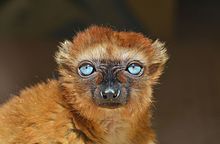Blue-eyed lemur
| Blue-eyed lemur | ||||||||||||
|---|---|---|---|---|---|---|---|---|---|---|---|---|

Blue-eyed Lemur ( Eulemur flaviofrons ), male |
||||||||||||
| Systematics | ||||||||||||
|
||||||||||||
| Scientific name | ||||||||||||
| Eulemur flavifrons | ||||||||||||
| ( Gray , 1867) |
The blue-eyed lemur ( Eulemur flavifrons ), also called Sclaters Maki (after the British zoologist Philip Lutley Sclater ) or turquoise-eyed lemur , is a species of primate from the family of common makis (Lemuridae) within the lemurs (Lemuriformes). It used to be considered a subspecies of Mohrenmakis (as Eulemur macaco flavifrons ), in 2008 it was given the status of an independent species.
features
Blue-eyed lemurs reach a body length of 39 to 45 centimeters, the long, bushy tail measures 51 to 65 centimeters, and their weight is about 1.8 kilograms. As with the Mohrenmaki, the sexes show a clear gender dichromatism , so are very differently colored. The males are black throughout, sometimes with a dark brown tinge. They have a characteristic short head of hair on the top of the head, in contrast to the black lemurs their fur is shorter, softer and the ear tufts are missing. The females are colored red-brown to red-gray on the upper side, the underside is white-gray, the hands and feet are dark gray. The top of the head is red, the face and muzzle are gray or brown. In contrast to the female black lemurs, they are generally lighter and the white tufts of ears are missing. The namesake feature are the blue or blue-gray eyes; besides humans, they are the only primates with this eye color.
distribution and habitat
Blue-eyed lemurs inhabit a small area in the northwest of the island of Madagascar , where they occur on the Sahamalaza peninsula and the adjacent mainland regions. There is a small region where the blue-eyed lemur hybridizes with the black lemur. The habitat of this species is the transition zone between the humid forests in the north and the dry deciduous forests in the south. These primates are relatively adaptable and can also be found in secondary forests and even in plantations.
Way of life
Little is known about the way these animals live. They usually stay in the trees and are cathemeral , that is, they do not have a distinct day-night rhythm. The degree of their nocturnal activity is related to the position of the moon; they are more active when the moon is bright. They live in groups of five to seven animals led by a dominant female.
Their diet consists primarily of ripe fruits and leaves, but they also eat insects, tree sap, flowers, mushrooms and occasionally small vertebrates.
After a gestation period of around 125 days, the female usually gives birth to a single young between August and October.
Threat and protection
After being lost for decades, the blue-eyed lemur was not rediscovered by French scientists until 1983. The main threats of this species include the destruction of their habitat through deforestation and shifting cultivation as well as hunting. Their distribution area covers less than 3000 km² and is very fragmented. The species is listed as " critically endangered " on the IUCN's Red List of Endangered Species . The zoos of Mulhouse , Cologne and Saarbrücken , together with the University of Strasbourg, have founded an initiative, the Association Européenne pour l'Etude et la Conservation des Lémuriens (AEECL), which is dedicated to the protection of these lemurs. A corresponding protected area has been set up on the Sahamalaza peninsula, which is scientifically supervised by the AEECL. As part of this initiative, scientists from the Cologne Zoo are conducting nutritional and parasite studies. You have set up a station that will be used for research purposes in the long term.
In addition to the protective measures on site, there are also small stocks that are kept in zoological gardens . These stocks currently include around 55 animals, of which almost 30 are in Europe (as of March 2009). The European conservation breeding program is coordinated by Mulhouse Zoo.
In German zoos there are currently two locations in the Tierpark Berlin and in the Cologne Zoo.
literature
- Nick Garbutt: Mammals of Madagascar. A Complete Guide. Yale University Press, New Haven CT 2007, ISBN 978-0-300-12550-4 .
- Thomas Geissmann : Comparative Primatology. Springer-Verlag, Berlin et al. 2002, ISBN 3-540-43645-6 .
Individual evidence
- ↑ R. Mittermeier, J. Ganzhorn, W. Konstant, K. Glander, I. Tattersall, C. Groves, A. Rylands, A. Hapke, J. Ratsimbazafy, M. Mayor, E. Louis Jr., Y. Rumpler , C. Schwitzer and R. Rasoloarison: Lemur Diversity in Madagascar. In: International Journal of Primatology 29 (2008), pp. 1607-1656.
- ↑ AEECL
- ↑ C. Schwitzer, A. Lork: "Projet Sahamalaza - Iles Radama": An international protection project for the Sclater's Maki ( Eulemur macaco flavifrons GRAY, 1867). In: Zeitschrift des Kölner Zoo 47 (2), 2004, pp. 75–84, and C. Schwitzer, W. Kaumanns: Blue-eyed black lemur ( Eulemur macaco flavifrons GRAY, 1867): Perspectives for in situ and ex situ - research and conservation activities. In: Proceedings of the 2004 EAZA Conference. Amsterdam: EAZA Executive Office, 2005.
- ↑ Information from the Cologne Zoo ( Memento of the original from June 26, 2008 in the Internet Archive ) Info: The archive link was inserted automatically and has not yet been checked. Please check the original and archive link according to the instructions and then remove this notice.
- ^ Information from ISIS International Species Information System
Web links
- Photos, videos and information at arkive.org
- Eulemur flavifrons onthe IUCN Red List of Threatened Species . Retrieved March 19, 2012.
